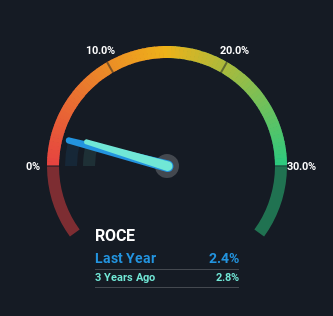- Japan
- /
- Metals and Mining
- /
- TSE:5711
These Return Metrics Don't Make Mitsubishi Materials (TSE:5711) Look Too Strong
When it comes to investing, there are some useful financial metrics that can warn us when a business is potentially in trouble. Businesses in decline often have two underlying trends, firstly, a declining return on capital employed (ROCE) and a declining base of capital employed. Ultimately this means that the company is earning less per dollar invested and on top of that, it's shrinking its base of capital employed. So after glancing at the trends within Mitsubishi Materials (TSE:5711), we weren't too hopeful.
What Is Return On Capital Employed (ROCE)?
For those that aren't sure what ROCE is, it measures the amount of pre-tax profits a company can generate from the capital employed in its business. Analysts use this formula to calculate it for Mitsubishi Materials:
Return on Capital Employed = Earnings Before Interest and Tax (EBIT) ÷ (Total Assets - Current Liabilities)
0.024 = JP¥28b ÷ (JP¥2.0t - JP¥901b) (Based on the trailing twelve months to December 2023).
Therefore, Mitsubishi Materials has an ROCE of 2.4%. Ultimately, that's a low return and it under-performs the Metals and Mining industry average of 6.2%.
View our latest analysis for Mitsubishi Materials

Above you can see how the current ROCE for Mitsubishi Materials compares to its prior returns on capital, but there's only so much you can tell from the past. If you're interested, you can view the analysts predictions in our free analyst report for Mitsubishi Materials .
What Does the ROCE Trend For Mitsubishi Materials Tell Us?
We are a bit worried about the trend of returns on capital at Mitsubishi Materials. About five years ago, returns on capital were 4.4%, however they're now substantially lower than that as we saw above. And on the capital employed front, the business is utilizing roughly the same amount of capital as it was back then. This combination can be indicative of a mature business that still has areas to deploy capital, but the returns received aren't as high due potentially to new competition or smaller margins. So because these trends aren't typically conducive to creating a multi-bagger, we wouldn't hold our breath on Mitsubishi Materials becoming one if things continue as they have.
Another thing to note, Mitsubishi Materials has a high ratio of current liabilities to total assets of 44%. This can bring about some risks because the company is basically operating with a rather large reliance on its suppliers or other sorts of short-term creditors. Ideally we'd like to see this reduce as that would mean fewer obligations bearing risks.
Our Take On Mitsubishi Materials' ROCE
In summary, it's unfortunate that Mitsubishi Materials is generating lower returns from the same amount of capital. In spite of that, the stock has delivered a 29% return to shareholders who held over the last five years. Regardless, we don't like the trends as they are and if they persist, we think you might find better investments elsewhere.
If you want to know some of the risks facing Mitsubishi Materials we've found 2 warning signs (1 is a bit concerning!) that you should be aware of before investing here.
For those who like to invest in solid companies, check out this free list of companies with solid balance sheets and high returns on equity.
New: Manage All Your Stock Portfolios in One Place
We've created the ultimate portfolio companion for stock investors, and it's free.
• Connect an unlimited number of Portfolios and see your total in one currency
• Be alerted to new Warning Signs or Risks via email or mobile
• Track the Fair Value of your stocks
Have feedback on this article? Concerned about the content? Get in touch with us directly. Alternatively, email editorial-team (at) simplywallst.com.
This article by Simply Wall St is general in nature. We provide commentary based on historical data and analyst forecasts only using an unbiased methodology and our articles are not intended to be financial advice. It does not constitute a recommendation to buy or sell any stock, and does not take account of your objectives, or your financial situation. We aim to bring you long-term focused analysis driven by fundamental data. Note that our analysis may not factor in the latest price-sensitive company announcements or qualitative material. Simply Wall St has no position in any stocks mentioned.
About TSE:5711
Mitsubishi Materials
Engages in the manufacture and sale of processed copper products and electronic materials, cemented carbide products, and businesses related to renewable energy in Japan.
Adequate balance sheet with slight risk.
Similar Companies
Market Insights
Community Narratives



